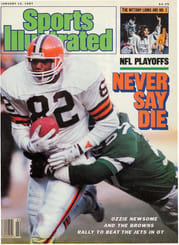
PRISON INMATES RUN, BUT NOT QUITE TO DAYLIGHT
Sir Roger Bannister testified to a unique feature of running when he remarked in his book The Four-Minute Mile, "I sometimes think that running has given me a glimpse of the greatest freedom a man can ever know, because it results in the simultaneous liberation of both body and mind."
That is what the athletic club at the Oregon State Penitentiary, in Salem, must have had in mind when it started a running program in 1981. Clinics were offered at the prison by such noted coaches as Arthur Lydiard, who trained Olympic gold medalists Peter Snell and Murray Halberg, and Bill Dellinger of the University of Oregon to help inmates develop their running skills. Local experts came to speak about nutrition and fitness. At first, the inmates ran in cutoff blue jeans and cheap tennis shoes, but in time running shorts were allowed by the authorities and the owner of a store catering to runners agreed to sell quality shoes at substantially reduced prices. Soon races were held on a quarter-mile track inside the prison. Later, with the approval of the penitentiary's administration, a one-mile loop was marked off inside the prison walls and special gates were installed so the loop could be opened on race days.
The running program, unlike any other program in the penitentiary, is administered by inmates. And as interest in it increased, so did the number of races held in the prison yard. The highlight of the penitentiary's running season has become the annual Make-A-Wish Benefit Marathon held in October. The benefit, which also includes a half-marathon and a 10K, is organized to raise funds to help realize the wishes of terminally ill children. Runners from outside the penitentiary are invited onto the prison grounds for this event to participate alongside the inmates. For one morning in October, the prison yard is transformed into something of a park, with the non-inmate runners dressed in all sorts of outfits and colors mingling with inmate spectators dressed in jeans and jackets and blue work shirts. Out of curiosity I entered the 10K race in last fall's Make-A-Wish Benefit.
All guest runners were required to arrive one hour prior to the start of their race in order to be processed into the penitentiary. At the prison reception desk I signed in behind a large contingent of Indian runners from a high school cross-country team and I walked through the "snitch box," an electronic metal detector. I then had the back of my hand stamped, which was my guarantee of safe passage out of the prison after the race. Silently the guest runners filed down a well-lighted corridor to a locked gate, which a guard opened, then continued down the corridor, which had two more gates.
"There's room for you people in D-Block if you get tired running," one of the guards cracked as we filed through the last gate.
Half a dozen inmates stared at us in stony silence as we left the corridor, and instinctively I turned my head away, feeling anxious for the first time. My pulse began to race as I realized I was now in the depths of a maximum-security penitentiary.
An inmate shepherded us across the rain-slickened yard to the prison recreation building, where we received our T-shirts and race numbers and got out of our sweat clothes. We then assembled at the starting line to receive race instructions. The sky was overcast, the air cool and damp. The marathon and half-marathon races were still in progress on the course, so we watched and encouraged the runners who ran past us while we waited for our race to begin.
I stood beside a lean, muscular inmate who repeatedly jabbed the air with his fists, which were wrapped in white tape. His hair hung to his shoulders. "Some days you eat the bear," he muttered to himself as he snapped his fists. "Some days the bear eats you." It seemed to me that he was strong enough to devour just about anything, and I stepped out of his reach toward the middle of the track.
At the start of the race the boxer burst toward the front of the 64-runner pack, his taped fists hanging idly at his sides. I stayed back, doubting if I could ever keep up with him. The first quarter mile of the race was on the track and then we proceeded onto the special one-mile loop that took us across stretches of asphalt, concrete, grass and bark dust inside the walls of the prison. Through the first circuit of the course, I almost forgot I was running inside a prison; I was pre-, occupied—as I would be in any race—with trying to establish a comfortable pace. Because many of the runners were guests, the field appeared similar to that of other races I had run; indeed, to my surprise, there were even a few women participating. For all I knew, I could have been running at home.
Heading into the second lap, however, I glanced up at one of the gun towers and saw an armed guard staring down at me. The shock of recognition startled me for a moment. I was not home at all, of course, but inside a prison running beside convicts. It was, without a doubt, the most unusual situation I had ever run in. Wherever I turned I saw the immense wall. Gradually I began to sense the oppressiveness that the inmates must endure on a daily basis. The feeling crept inside of me like a small insect, gnawing at my nerves, and I began to quicken my pace a notch, as if to escape from my emotions. I passed the boxer easily, passed all of the members of the high school cross-country team, and wished that I could gather enough speed to pass everyone on the course.
Soon I had passed all of the inmates but one—a short, supple Indian runner who wore his long hair in braids. I stalked him for several meters before passing him as we moved into the last lap. The harder I ran, the more my edginess seemed to dissipate. I was able to ignore the wall and the guards in the gun towers, and instead focus my attention on finishing the race. But then, with a quarter of a mile remaining, I heard footsteps behind me. Suddenly, the Indian inmate surged past me, his long braids twisting across his back.
I ran after him but he continued to move ahead. He was running as hard as I had ever seen anyone run, his arms churning and his head tossing from side to side. Even if I had just begun to run at that instant, I doubt if I could have caught him. Now he, too, was able to ignore the immense wall that surrounded him day and night. Running for him, as perhaps for all runners, was not drudgery but freedom.
ILLUSTRATION
MARK LANGENECKERT
Inveterate distance runner T.R. Healy is a free-lance writer in Portland, Ore.

